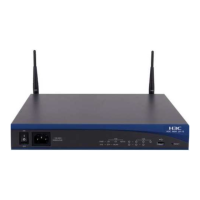3. Establish tunnels between PEs to transmit user data.
4. Enable MPLS L2VPN on PEs.
5. Create VSIs on PEs, use the signaling protocol as LDP, and bind VSIs to related AC
interfaces.
Data Preparation
To complete the configuration, you need the following data:
l Names and IDs of VSIs
l IP addresses of peers and tunnel policy used for setting up peer relationships
l Interfaces to which VSIs are bound
Procedure
Step 1 Configure the VLAN to which each interface belongs according to Figure 6-5.
The configuration details are not mentioned here.
NOTE
The S9300 only allows the CE to access the PE through a trunk.
Do not add the AC-side port and PW-side port of a PE to the same VLAN; otherwise, a loop may occur.
Step 2 Configure an IGP. In this example, OSPF is adopted.
When configuring OSPF, advertise 32-bit loopback interface addresses (LSR IDs) of PE1, P,
and PE2.
The configuration details are not mentioned here.
After the configuration is complete, run the display ip routing-table command on PE1, P, and
PE2. You can view the routes learned by PE1, P, and PE2 from each other.
Step 3 Configure basic MPLS functions and LDP.
The configuration details are not mentioned here.
After the configuration, run the display mpls ldp session command. You can find that the
Status of the peer relationship between PE1 and PE2 is Operational, which indicates that the
peer relationship is established. Run the display mpls lsp command, and you can view the setup
of the LSP.
Step 4 Establish remote LDP sessions between PEs.
# Configure PE1.
[PE1] mpls ldp remote-peer 3.3.3.9
[PE1-mpls-ldp-remote-3.3.3.9] remote-ip 3.3.3.9
[PE1-mpls-ldp-remote-3.3.3.9] quit
# Configure PE2.
[PE2] mpls ldp remote-peer 1.1.1.9
[PE2-mpls-ldp-remote-1.1.1.9] remote-ip 1.1.1.9
[PE2-mpls-ldp-remote-1.1.1.9] quit
Quidway S9300 Terabit Routing Switch
Configuration Guide - VPN 6 VPLS Configuration
Issue 03 (2009-08-20) Huawei Proprietary and Confidential
Copyright © Huawei Technologies Co., Ltd.
6-39

